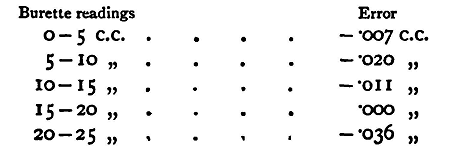| Practical Physics is a free textbook on basic laboratory physics. See the editorial for more information.... |

|

Home  Measurement of the More Simple Quantities Measurement of the More Simple Quantities  Volume Volume  Graduation of a Burette Graduation of a Burette |
||






|
||
Graduation of a Burette
Suppose the burette to contain 100 c.c.; we will suppose also that it is required to test the capacity of each fifth of the whole.
Fill the burette with water, and read the position of the line on the float. Carefully dry and weigh a beaker, and then run into it from the burette about 1/5th of the whole contents; read the position of the float again, and weigh the amount of water run out into the beaker. Let the number of scale divisions of the burette be 20.2 and the weight in grammes 20.119. Read the temperature of the water; then, knowing the density of water at that temperature (from table 32), and that 1 gramme of water at 4° C. occupies 1 c.c., we can determine the actual volume of the water corresponding to the 20.2 c.c. as indicated by the burette, and hence determine the error of the burette. Proceeding in this way for each 1/5th of the whole volume, form a table of corrections. Experiment. - Form a table of corrections for the given burette. Enter results thus:
|
||
Home  Measurement of the More Simple Quantities Measurement of the More Simple Quantities  Volume Volume  Graduation of a Burette Graduation of a Burette |
||
Last Update: 2011-03-27


